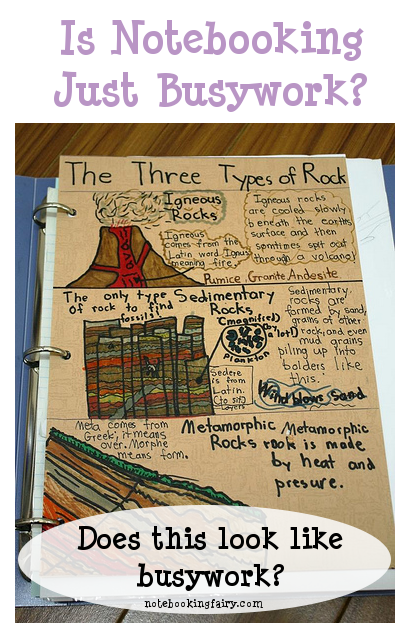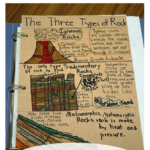- in How-tos , Q & A by Jimmie Quick
Is Notebooking Useless Busywork or Real Learning?
I am generally surprised when I see critics of notebooking. It is such an open-ended method of learning that I can’t imagine why someone would dislike it. It works for all ages, all subjects, and even for reluctant writers.
One criticism I see is that notebooking is busywork.

Notebooking can be busywork. I will admit that. You can take a worksheet and call it notebooking, but that worksheet is still busy work. Some printable notebooking pages are really worksheets under a new label.
Worksheet or Notebooking Page? Take the Test
Here is the criteria to find out if a page is a worksheet or a notebooking page: look at the ratio of words to empty space.
1. If the page is mostly empty space for writing, drawing, or pasting, it is likely a notebooking page.
2. If the page has heavy text, many words, and little room for the student’s own thoughts, it is likely a worksheet.
Notebooking is a medium for a learner to demonstrate his knowledge. If you try to control that demonstration too much with too many leading questions and too many prescribed blanks, you are veering into worksheet territory.
There is a big difference between free reign notebooking (with blank paper on one end of the spectrum) and workbook pages (with small lines to write in single word answers). But notebooking can incorporate everything on that continuum and be very effective for your child’s learning.
What’s Wrong with Worksheets?
Worksheets have a place in learning. They can offer a quick review of something you don’t choose to invest a lot of time into. Worksheets can be a great way for reluctant writers to get their thoughts on paper — there is less of that scary empty space.
Worksheets can provide a scaffold for students learning how to organize information. The worksheet guides them what to put where.
Some of my printables at The Notebooking Fairy fall closer to the worksheet side of the continuum. Examples would be the animal page, country page, and explorer page.
Is it bad to use these pages? Goodness no! They are not requiring as much thought as blank pages, but some learners need that help with structuring their research or narration. I see these pages as a help for learners just starting out with notebooking, a graphic organizer to springboard to more detailed writing, or a quick assignment when you don’t want to dwell on a topic.
Notebooking is Not Busywork
Other critics of notebooking associate it with lapbooking. They find cutting out those little flaps silly and tedious. You can incorporate elements of minibooks onto your notebooking pages, but you don’t have to. You can take a scrapbook approach, or you can go with straight text. The bottom line is this — does the structure of the notebooking page help your child arrange information?
I am not a fan of those silly single flap minibooks that have a question on the outside that the child answers on the inside. That is a glorified worksheet, cut into little bits of folded paper. But if a minibook’s structure reflects the information being conveyed, then that minibook has serious cognitive value.
For example, if I’m studying the three parts of an insect’s body, and my minibook has three distinct flaps, I have made a concrete connection between the ideas and the physical book. That is not busywork. That is learning.
When you prompt your child to narrate her lessons with an open-ended question, that is not busywork. The writing that follows is composition. This is why notebooking works even in high school and serves to hone your child’s writing skills. Think of each notebooking assignment as an answer to an essay question on a test. That surely is not busywork.
In closing, I do want to offer you an escape clause. As I would say for any strategy, if notebooking doesn’t work for you child, don’t use it! There are so many options for homeschool that it’s silly to suffer through something that isn’t working. But don’t discount notebooking because you think it is busywork. Give it a try, using it as an open-ended way to narrate lessons. Let your child be creative with choosing the structure and the format. You will find it a rich alternative to worksheets and comprehension questions at the end of the chapter.
This post is part of the iHomeschool Network link-up Answering the Homeschool Critics. Click to read more answers to common homeschool criticisms.

